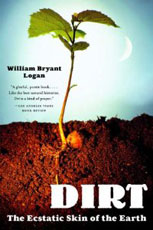"The soil is all of the earth that is really ours. The seasons, with their heat and their cold make the soil. The storms make the soil, with water, the most powerful substance on Earth. The winds make the soil, spreading dust across thousands of miles. The tides make the soil, stirring the river deltas and their fertile slimes. And above all, the trees and the plants, the dead and the digested, the eaters and the eaten, make the soil.
"The mouth of the Mississippi River spews fifteen tons of sediment per second into the Gulf of Mexico; every American acre gives up an average of more than ten tons of soil each year. Fully seventy-five percent of the earth's surface is made of such moving or cemented sediment.
"Dirt is the gift of each to all. It is not so grand in appearance as even the muddiest shale. An ancient soil may be no more than half a million years old, piddling compared to any rock. In a hot, wet place like the South Seas isle of Krakatoa, new soil may form at a rate of better than one half inch per year, while on dry lands, it may take better than a quarter of a century to do the same; but the metamorphic rock of the shields is more than three billion years old. A tectonic plate of the earth's crust is as much as fifty miles thick; a soil may be as thin as a lichen. It would seem incommensurable. The soil is so young and fragile compared to stones. But youth and fragility are fruitful.
"Soil appears where life does, and its characteristic is to build where erosion destroys. On the face of a stone a lichen takes hold. The lichen digests minerals and is itself digested by the microbes in the air. The combined detritus falls, fills a cleft in the rock. A club moss roots in this compost, lives, and dies. The cleft overflows. Grass seeds blow in, grass grows.
"It is the nature of soil to build aggregates: plates or blocks or chunks, full of air and water channels. Gardeners in fact know their soils first and foremost by the size of the particles and the kinds of aggregates they build. Where organic decay and inorganic erosion meet, the conditions exist for a fertile soil, because the two in combination make a tortuous, knotty structure that offers roots the optimum mixture of mineral nutrients, organic nutrients, air, and water.
"Everywhere, creatures and minerals together make their characteristic soils. Where the grand circulation exposes different bands of rock in juxtaposition, so the plant communities that come to live on them differ, and the resulting soils do too.
"On a field trip once, the great soil scientist Hans Jenny had me drive down a side road in Sonoma County. California. Beside us ran a field of wild grass with oaks scattered on the knolls. Abruptly, the vegetation turned into a scraggly stand of digger pine. We stopped the car to look for the difference. Beneath the oaks, the broken rock was schist; underlying the grassland were sandstones; but the sparse pines grew on a pretty, green stone. Serpentine is the state rock, it's so attractive, but it is also full of chromium and nickel, discouraging to most plants.
"Here, we used our eyes to conceive the livingness of the world. I had driven past that landscape all my life, my eyes on the road ahead, noticing the 'beauties' but really observing nothing at all. Here, by an oily roadside, with traffic sweeping by, I stepped out of time and into beauty, thanks to a ninety-year-old man who actually knew something. I could feel the earth spinning on its axis.
"We spend our lives hurrying away from the real, as though it were deadly to us. 'It must be somewhere up there on the horizon,' we think. And all the time it is in the soil, right beneath our feet."
